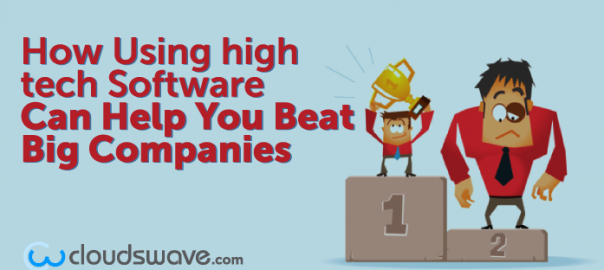
It’s an exciting time to be the owner of a small business.
Digital and Internet technology has reached a point where anyone can sell products and services to virtually anyone else. And every day, new innovations give small businesses more options:
For example, small business owners are finding new ways to market themselves and reach more customers.
In the modern world, it’s not uncommon to find a small business run inside a home and with a larger customer base than a brick-and-mortar store.
The old requirements for running a business no longer exist:
Think of the way Instagram and sites like Etsy have revolutionized the way people sell jewelry, arts, and crafts. Software is making it easier than ever to run an efficient and well organized business. While technology doesn’t guarantee the success of a small business, in the right hands, it’s a powerful tool.
What to expect from this article ?
Divided into multiple sections, this article aims to assist small businesses to take advantage of the power of software and stay relevant and competitive in a cutthroat industry where the larger players usually have the edge:
- How software helps small businesses
- Why small businesses are poised to benefit more from software implementation
- Challenges to small business software implementation
- Streamlining your technology and software investments
- Taking a thoughtful approach to software implementation
How can software help small businesses?

Many small businesses now believe they can leverage technology to help them compete with larger companies, and they’re right. Software lets small businesses operate on a level comparable with their much larger competitors.
Small businesses that don’t make use of these technologies are placing themselves at a competitive disadvantage.
Here are some of the ways software can help small businesses:
- Automate processes
- Organize data
- Advertise and reach a targeted audience
Now, let’s dig into each a little deeper.
Automate processes

Anyone who’s ever run a small business knows how tiring and difficult it can be. There are dozens of things an owner must keep track of at once, and finding time for every aspect of a business can be a real challenge.
There are small business software solutions to automate processes, so that a small company can address all of its priorities despite a small staff:
- Bookkeeping
- Email blasts
- Marketing
- Inventory
- Invoicing
These are all examples of business tasks that require a significant amount of time and manpower.
In the past, it could be a struggle for a small business with limited staff to take care of all these priorities. With the software available today, many of these processes can be fully or partially automated, and that saves the business crucial time and money.
Organize your data

Data organization is another key innovation helping small businesses:
- Data is intelligence
- Effective use of available data can help small businesses increase revenue and lower costs
- Data helps small businesses make better decisions
The only problem is that large amounts of data can be difficult to organize and manage.
Fortunately, there’s an app for that.
For example, CRM software empowers businesses to keep careful track of all sales data, including records of prospects and potential leads, helping a small business with a limited sales team prioritize and optimize their opportunities.
Other types of business management software organize other forms of data, such as financial data, invoices, and HR information.
Advertise and reach a targeted audience

Marketing and advertising have always been a critical part of running a small business.
In the past:
- Companies required large advertising budgets on channels like newspaper, radio, and television.
- Those without a huge advertising purse were unable to compete or reach a large group of people.
With the advent of the Internet and digital mobile technologies, this is no longer the case. Getting the attention of your audience can be difficult, but reaching an audience has never been easier:
- For businesses that lack large budgets or marketing staff, web marketing software facilitates targeting and communicating with your audience. These programs allow a small business owner to quickly automate and organize their marketing.
- Email blasts are another area where software excels. You can organize your email lists into different groups, so you can effectively target your customers. The organizational criteria can be anything such as what products customers like, the last time they’ve contacted you, and what state they live in. Targeted advertising used to be difficult even for the largest companies, but now, anyone can do it.
Some essential points to keep in mind about marketing automation software:
- The software can be used to automatically send out messages every couple days or weeks, or automatically send them out after a person completes an action on your website, allowing small businesses to provide consistent marketing even without the staff or time to work every day on it.
- Marketing automation is powerful in that it lets you measure your marketing by analyzing how many clicks or purchases you’re getting from online ads or emails, as well as who is doing the purchasing. This enables you to refine and improve your marketing, plus give you more information about the audience you’re reaching.
Small businesses are poised to benefit most from these technologies
Large businesses can also implement these technologies, but they do not benefit as much as small businesses simply because the latter have the agility and flexibility to more efficiently implement the newest software.
A large business wanting to bring in a new on-premise program will have to install it into hundreds or thousands of computers. This represents a substantial change to system architecture and requires a complicated IT strategy and a gradual roll-out.
Once the technology is put in place, the training and education needed entails a tremendous amount of time and money.
Small businesses can avoid all these complications.
Why?
In a small organization, changing processes can be done quickly and efficiently. Training and education can be handled slowly or quickly, but with less staff, it is significantly less expensive.
Now:
Imagine a small company as a compact car and a large company as a semi-truck with a 53-foot trailer. If they’re both driving down the same road and realize they need to turn around, which one do you think can turn around more quickly?
Small companies can take advantage of this maneuverability by constantly looking for the newest software and technologies. Their implementation costs are insignificant compared to a large company, and they can continuously leverage software as a competitive advantage.
New technology is a game changer for small businesses
To really understand why software helps small businesses compete, you must think about what software gives to small and large businesses.
Small businesses are able to do things they were never previously able to:
- Handle complex tasks
- Organize large sets of data
- Market to thousands of people at a time
Large businesses always had these capabilities.
While software is used by large businesses to save money and become more efficient, its effect is much more profound for small businesses. Software gives small businesses new capacities they never had and access to markets they could never reach in the past, completely changing the way they do business.
Small business obstacles

All that being said, it doesn’t follow that running a small business has suddenly become so easy. It’s still an incredibly difficult endeavor.
Think of the following challenges to small business software implementation:
- New software and technologies don’t mean anything if you don’t understand and use them.
For small business owners to compete, they must constantly be on the lookout for new technologies. They also must have a really strong understanding of how software can help their business. It’s a serious time investment, and some small business owners simply don’t understand how to use technology to the fullest.
- It can be difficult to know which technology and software is most critical to your company’s success.
A large company can have a Senior Vice President of Technology or a Vice President of Systems Innovation. On the other hand, small businesses usually lack a staff person who can concentrate their time on analyzing new software and finding out which ones are helpful.
- Software can be expensive, and small businesses may not have the necessary funding to invest in software, IT staff, and training.
With less money and manpower, it’s critical that small business leaders correctly identify which software to adopt and when to adopt them. Some businesses work with consultants and other advisors to find the right software and make the right technology decisions.
The importance of streamlining

Because time, money, and manpower are limited resources for many small businesses, it’s crucial that they identify the best software options and only invest in those that make a difference to the bottom line.
This is a very confusing process because there are hundreds of different technology and software choices out there, and parsing through all the noise is not easy.
Before investing in technology:
- Think critically about exactly how it will help you.
Only technologies that provide clear and consistent value should be purchased and implemented. For example, it may seem like a good idea to buy your salesmen tablets because then they can also work while commuting or at home. In your mind, this will help them provide better and quicker response to customers – but think critically.
- How much more productive will they be on a tablet than simply replying to emails from their smartphones?
- It’s possible for them to respond more effectively and do more complex tasks on their tablets, but how often do you expect your employees to work on complicated tasks while they’re at home?
You should also think about the costs associated with changing your sales process and the risk of losing the tablets along with confidential company and client data. For some companies, buying tablets may be a worthwhile investment, but for many, it isn’t.
- Remember that more isn’t always better and complex isn’t always smart.
One of the greatest advantages of small businesses over their larger counterparts is that they’re leaner and more agile. But if you repeatedly invest in unnecessary and redundant software, you’re minimizing that advantage.
Even when new technology does not slow down the process and is only used in special situations, there’s a cost to the training and implementation. Is the cost worth it? Some programs will be transformative to your business, but some won’t be.
Therefore:
It’s critical to streamline your software and technology investments, so you’re only implementing what’s necessary and most productive.
A thoughtful approach to software implementation

Software is a double-edged sword. Making the wrong choices hurts productivity and wastes precious time and resources. Every small business needs a comprehensive technology and IT strategy, and this is started by identifying the areas that are inefficient and detrimental to productivity.
- What areas could be improved?
- What types of technologies would make the business more efficient, productive, and profitable?
After identifying their specific needs, small businesses can take a thoughtful approach to software implementation. It’s simply a matter of matching the software to the problem.
Many providers offer trials and training, so businesses can determine if the software can actually improve their processes. For companies to get the most from their investment, Cloudswave and other services help determine the best software in different categories.
In conclusion
When a small business adopts a software strategy with clear goals and objectives, it finds transformative solutions that make a difference to the bottom line. There are so many new technologies available that are revolutionizing how small businesses operate and conduct business.
Proper utilization of these technologies gives small business owners the chance to fully compete with larger companies and grow at rates faster than ever imagined.
(277)






